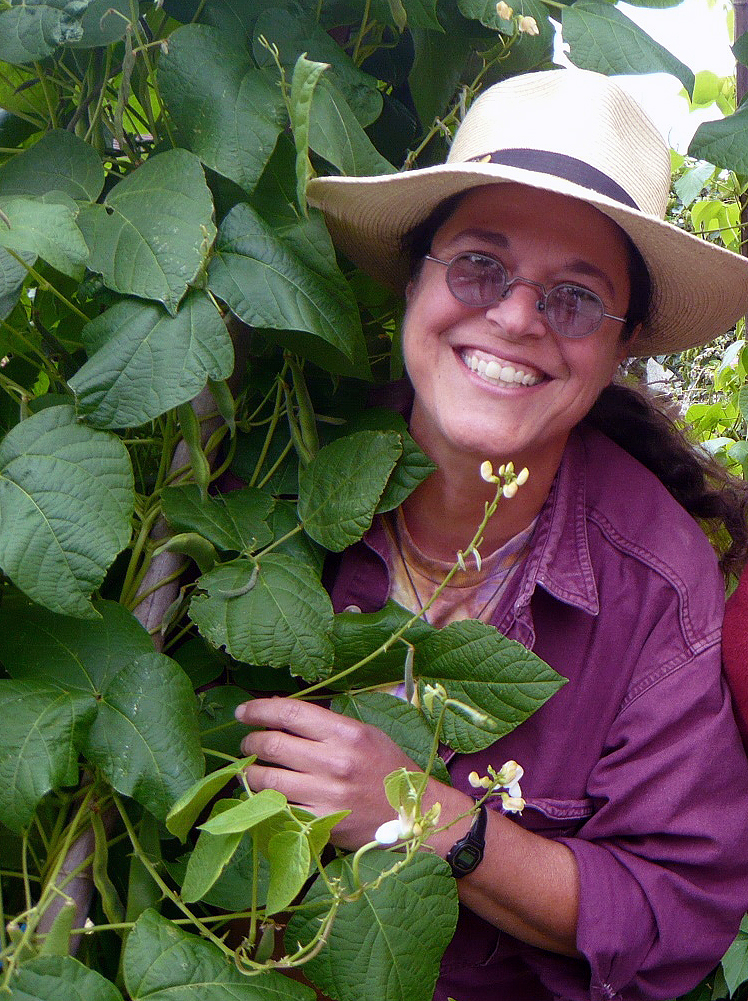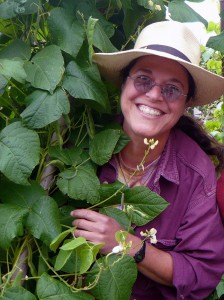(Click on any image for a larger view.)
I envisioned a yard filled with vegetables and herbs, with fruit trees along the fence line, and grapevines climbing an arbor over our porch swing. I wanted a place where I could pick my dinner just moments before it came into the kitchen. And that’s exactly what I have now.
Lisa Taylor, author, Your Farm in the City
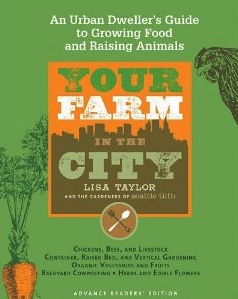 Lisa Taylor, Seattle Tilth Education Programs Manager, author of Your Farm in the City: An Urban Dweller’s Guide to Growing Food and Raising Animals, teaches everyone from toddlers to oldsters to feel the soil, plant seeds, develop “relationships” with their plants, and grow their own food. She has advice for growing food in spaces as small as a window box or as large as a city lot.
Lisa Taylor, Seattle Tilth Education Programs Manager, author of Your Farm in the City: An Urban Dweller’s Guide to Growing Food and Raising Animals, teaches everyone from toddlers to oldsters to feel the soil, plant seeds, develop “relationships” with their plants, and grow their own food. She has advice for growing food in spaces as small as a window box or as large as a city lot.
Across the country, spring can’t come soon enough and the call to garden is getting louder and louder. We had the opportunity to speak to Lisa and get a little advice for new and beginning gardeners. It’s never too early – or too late – to tuck a few seeds in some soil and get growing!
GoodFood World: As experienced gardeners, new gardeners, and would-be gardeners look forward to getting seed in the soil, what should those of us who live in the maritime Northwest do now to get ready – or start – to garden?
Lisa Taylor: It’s the beginning of spring gardening season and March is a great month for sowing seeds indoors and out. It’s time to get cool season crops like lettuce and spinach in the ground. And if you have the ambition – and skill or inclination – to start some of the heat loving plants like tomatoes and peppers, it’s not too late.
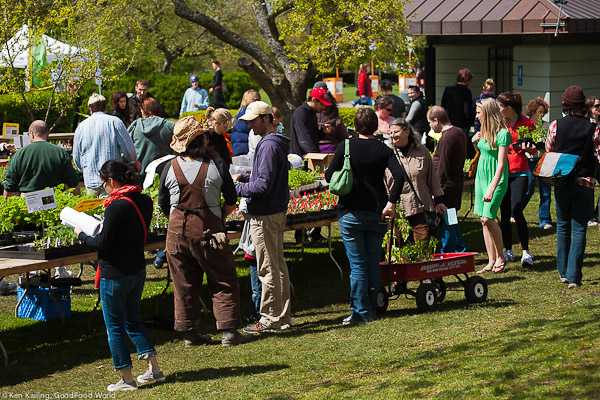
While we’d all like to start digging in the garden, it’s been really wet so cultivating the soil is a little tricky. Before you mess around out there, check your soil moisture. A good simple test is to dig down about 4-6 inches, grab a handful of soil, and form a loose ball with it. Throw the ball of dirt up in the air six or eight inches and let it fall back into your hand. If it stays together in a ball, it’s too wet. If it breaks apart easily then it’s OK to work.
I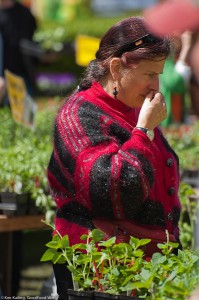 f it’s too wet and you just can’t want to get going, don’t cultivate it; you’ll wreck the soil structure. We’ve had a very wet March, so it should dry out just a little. Put of a cover of come kind – a cloche, tarp, or waterproof cover – over the soil to keep the soil from getting wetter and to help it dry out. While you’re waiting for things to get drier, you can set up a propagation area or some containers and start growing some seeds inside.
f it’s too wet and you just can’t want to get going, don’t cultivate it; you’ll wreck the soil structure. We’ve had a very wet March, so it should dry out just a little. Put of a cover of come kind – a cloche, tarp, or waterproof cover – over the soil to keep the soil from getting wetter and to help it dry out. While you’re waiting for things to get drier, you can set up a propagation area or some containers and start growing some seeds inside.
In January, I get the urge to start growing something, and I know that if I start too early I’ll have failures. So this year I doubled my propagation space – the light/heat area I have for growing plants indoors. I started a couple of flats of greens just to eat. I just planted a bunch of old seeds – some that were 5 years old or more – and I combined all kinds together. So we had “cut and come again” baby lettuce and other greens and I’m cutting the third harvest now. It’s been fun gardening inside.
Because the propagation medium isn’t very fertile I fertilize them with liquid fish fertilizer every week or two to make sure they have enough nutrients. Propagation medium is meant to be used just to get seeds started, not for them to grow in for any length of time, like the micro-greens I’m harvesting.
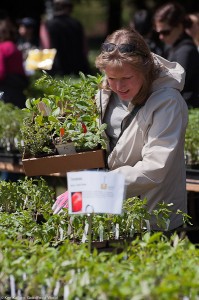 For years I just bought starts but the last few years I’ve slowly converted to growing my own. My propagation area is just some shop lights hanging over a counter in the basement. The flats are laid out on a propagating pad that holds four trays and heats them from below. Above it are three sets of 2-bulb fixtures on adjustable chains that I can move up and down as needed. I start the seeds in trays, then move them to 4-inch pots to get big enough to transplant in the garden.
For years I just bought starts but the last few years I’ve slowly converted to growing my own. My propagation area is just some shop lights hanging over a counter in the basement. The flats are laid out on a propagating pad that holds four trays and heats them from below. Above it are three sets of 2-bulb fixtures on adjustable chains that I can move up and down as needed. I start the seeds in trays, then move them to 4-inch pots to get big enough to transplant in the garden.
GoodFood World: What advice do you have for someone who is gardening for the very first time? The seed catalogs are way too exciting and so tempting; it’s hard to know what to choose.
Lisa Taylor: For someone who’s a brand new gardener and has never put a seed in the ground, I recommend a little caution. Read a seed catalog like a novel… it’s the copywriter’s job to make everything sound really good.
Pick something that’s easier to grow and grow things in their proper season. Greens and brassicas, for instance, are super simple to grow in Puget Sound. Peas are a long season crop and they need a lot of care before you can harvest. They grow easily, but if you’re not used to getting out and caring for something for a long period, you might want to choose something that’s “short season” like lettuce and spinach, or use starts rather than seeds.
If you scatter seed in a prepared bed, they come up with a bunch of weeds and as a new gardener you may not know what’s what. And then you just don’t do anything… If you get starts, you already know what to water, where to put the compost, and you can start a relationship with your plants. Then next year plant some seeds.
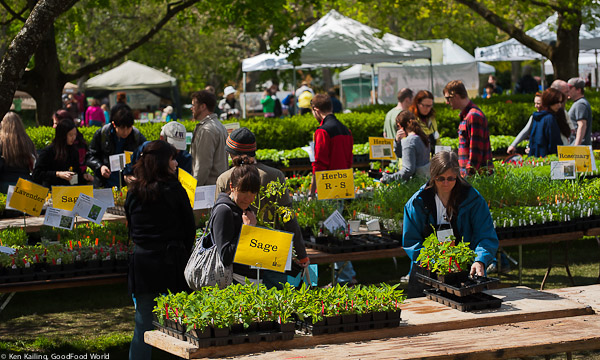 All the kids’ books start with growing carrots, but carrots take a long time to grow. They take time to germinate and you have to keep them moist that whole time. If you’re not in the habit of getting out and caring for things on a regular basis… it’s tough to keep things going. Most people fail at gardening because of neglect not lack of skill.
All the kids’ books start with growing carrots, but carrots take a long time to grow. They take time to germinate and you have to keep them moist that whole time. If you’re not in the habit of getting out and caring for things on a regular basis… it’s tough to keep things going. Most people fail at gardening because of neglect not lack of skill.
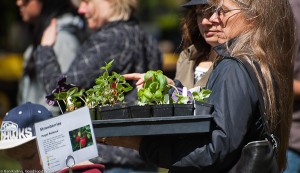 My “new age, metaphysical take” on gardening is that it’s just about caring for living things. You develop a relationship with your plants and that gives you the impetus to go out and care for them. Then they give a lot back… the colors, the whole “plant vibe” is super nourishing for people. But you have to have a commitment and relationship; once you have a relationship you’re not going to let something die, are you? People go to crazy, extraordinary means to keep things they care for alive. That’s the real starting point – developing a relationship with your plants and garden.
My “new age, metaphysical take” on gardening is that it’s just about caring for living things. You develop a relationship with your plants and that gives you the impetus to go out and care for them. Then they give a lot back… the colors, the whole “plant vibe” is super nourishing for people. But you have to have a commitment and relationship; once you have a relationship you’re not going to let something die, are you? People go to crazy, extraordinary means to keep things they care for alive. That’s the real starting point – developing a relationship with your plants and garden.
Develop a routine, muscle memory… When I start seeds, I need to check in on them every day. If they’re on heat, I really have to watch them and water them because they dry out faster. It’s just part of the plan.
GoodFood World: We’ll start to see tomato starts at the big box stores already in April. When should we really be putting tomatoes in the ground here in Puget Sound?
Lisa Taylor: That depends, every garden is different. If you have a super hot microclimate with 8 hours of full sun every day, you’ve got the perfect spot to plant your tomatoes early. But if you don’t have all of that – if any element is missing – all bets are off. If you’ve already hardened them off – or bought them from a nursery that has had them on a rack for weeks – you can plant them in mid-May if you keep them under cover with a cloche for example. Or if you won’t be covering them, wait until the end of May or early June to plant tomatoes.
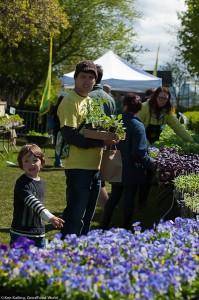 With basil you should wait even longer. I buy basil starts when they’re 3 for $10 in July. By then everyone else has given up because they started too soon. Basil is the most tender of the annuals that we grow here. It’s the very last thing to go out, but it will grow pretty fast once the weather is warm.
With basil you should wait even longer. I buy basil starts when they’re 3 for $10 in July. By then everyone else has given up because they started too soon. Basil is the most tender of the annuals that we grow here. It’s the very last thing to go out, but it will grow pretty fast once the weather is warm.
If people are itching for tomatoes, they can start them inside now and be ready to put them out when the weather is perfect. I have heirloom tomatoes that I’m growing out now.
New gardeners shouldn’t invest a lot in tomatoes the first year unless they’re into experimentation. If you have to have a tomato plant, go for a good cherry tomato like Chadwick’s Cherry. It’s a giant plant with big fruit, and produces just a ton.
Carl Elliot, local gardening guru, says, “The first five flower clusters will be vine-ripened.” So if all you want is vine-ripened fruit, be ruthless about pruning off buds. If you want to wait a little longer, all of the buds and flowers should be removed the first week of August at the latest, so you’ll get good fruit by the end of the season. Some may just have to be ripened on the windowsill.
What to do with all those green tomatoes? I’ve made some great recipes with green tomatoes. Last year I had tons of green tomatoes and made a sweet pickle relish with them. I always make green tomato muffins. The muffin recipe is in Your Farm in the City, on page 252.
For anyone just getting started gardening, my best advice is to start small, have fun, and eat what you grow!
Resources
Urban Agriculture – Growing Your Own
Your Farm in the City: An Urban-Dweller’s Guide to Growing Food and Raising Animals by Lisa Taylor
Joshua McNichols talks about The Urban Farm Handbook
Growing Your Own – Time to Get Gardening!

